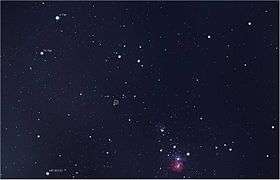VX Sagittarii
 VX Sgr, circled | |
| Observation data Epoch J2000.0 Equinox J2000.0 (ICRS) | |
|---|---|
| Constellation | Sagittarius |
| Right ascension | 18h 08m 04.04831s[1] |
| Declination | −22° 13′ 26.6327″[1] |
| Apparent magnitude (V) | 6.5 - 14.0[2] |
| Characteristics | |
| Evolutionary stage | Red Hypergiant |
| Spectral type | M4eIa - M10eIa[3] |
| Apparent magnitude (U) | 11.72 |
| Apparent magnitude (B) | 9.41 |
| Apparent magnitude (V) | 6.52 |
| Apparent magnitude (I) | 2.11 |
| Apparent magnitude (J) | 1.23 |
| Apparent magnitude (H) | 0.13 |
| Apparent magnitude (K) | −0.50 |
| Apparent magnitude (L) | −1.61 |
| Variable type | SRc[2] |
| Astrometry | |
| Radial velocity (Rv) | +30 (variable)[4] km/s |
| Proper motion (μ) | RA: 3.20 mas/yr Dec.: -6.71 mas/yr |
| Parallax (π) | 3.82 ± 2.73[1] mas |
| Distance | ≈ 5.15k ly (1.57k[5] pc) |
| Details | |
| Mass | 12[6] M☉ |
| Radius | 1,350–1,940[7] R☉ |
| Luminosity | 110,000–190,000[7] (–340,000[8]) L☉ |
| Temperature | 2,400–3,300[7] K |
| Other designations | |
| Database references | |
| SIMBAD | data |
VX Sagittarii is a late-type red supergiant or hypergiant pulsating variable star located more than 1.5 kiloparsec away from the Sun in the constellation of Sagittarius. It is one of the largest stars discovered so far, although the radius is poorly known. Its radius is approximately between 1,350 - 1,940 solar radii.
Stellar characteristics
The star is classed as a cool semiregular variable of type SRc with a pulsational period of 732 days. The variations sometimes have an amplitude comparable to a long period variable, at other times they are much smaller. The spectral type varies between M4e around visual maximum and M9.8e at minimum light, and the luminosity class is Ia indicating a bright supergiant. The spectrum shows emission lines indicating that the star is losing mass through a strong stellar wind.[7]
The effective temperature is also highly variable from around 2,500K at minimum to around 3,500K near maximum,[9] and with an average temperature given as 2,900 K. Such low temperatures are comparable to the very coolest AGB stars and unprecedented for a massive supergiant.[7] The atmosphere is highly extended, irregular, and variable during the pulsations of the star. The size at its faintest and coolest has been calculated to be 1,940 R☉ compared to 1,350 R☉ at the hottest and brightest.[7]
The atmosphere of VX Sgr shows molecular water layers and SiO masers in the atmosphere, typical of an OH/IR star.[10] The masers have been used to derive an accurate distance of 1,590 parsecs.[5] The spectrum also indicates strong VO and CN. In many respects the atmosphere is similar to low mass AGB stars such as Mira variables, but a supergiant luminosity and size.[6]
References
- 1 2 3 Van Leeuwen, F. (2007). "Validation of the new Hipparcos reduction". Astronomy and Astrophysics. 474 (2): 653. arXiv:0708.1752
 . Bibcode:2007A&A...474..653V. doi:10.1051/0004-6361:20078357.
. Bibcode:2007A&A...474..653V. doi:10.1051/0004-6361:20078357. - 1 2 Samus, N. N.; Durlevich, O. V.; et al. (2009). "VizieR Online Data Catalog: General Catalogue of Variable Stars (Samus+ 2007-2013)". VizieR On-line Data Catalog: B/gcvs. Originally published in: 2009yCat....102025S. 1. Bibcode:2009yCat....102025S.
- ↑ Kiss, L. L.; Szabó, G. M.; Bedding, T. R. (2006). "Variability in red supergiant stars: Pulsations, long secondary periods and convection noise". Monthly Notices of the Royal Astronomical Society. 372 (4): 1721. arXiv:astro-ph/0608438
 . Bibcode:2006MNRAS.372.1721K. doi:10.1111/j.1365-2966.2006.10973.x.
. Bibcode:2006MNRAS.372.1721K. doi:10.1111/j.1365-2966.2006.10973.x. - ↑ Knapp, G. R.; Sutin, B. M.; Phillips, T. G.; Ellison, B. N.; Keene, J. B.; Leighton, R. B.; Masson, C. R.; Steiger, W.; Veidt, B.; Young, K. (1989). "CO emission from evolved stars and proto-planetary nebulae". The Astrophysical Journal. 336: 822. Bibcode:1989ApJ...336..822K. doi:10.1086/167052.
- 1 2 Chen, X.; Shen, Z. Q.; Xu, Y. (2007). "Measuring the Distance of VX Sagittarii with SiO Maser Proper Motions". Chinese Journal of Astronomy and Astrophysics. 7 (4): 531. doi:10.1088/1009-9271/7/4/09.
- 1 2 Chiavassa; Lacour; Millour; Driebe; Wittkowski; Plez; Thiebeaut; Josselin; Freytag (2009). "VLTI/AMBER spectro-interferometric imaging of VX Sgr's inhomogenous outer atmosphere". Astronomy and Astrophysics. 511: A51. arXiv:0911.4422
 . Bibcode:2010A&A...511A..51C. doi:10.1051/0004-6361/200913288.
. Bibcode:2010A&A...511A..51C. doi:10.1051/0004-6361/200913288. - 1 2 3 4 5 6 Lockwood, G.W.; Wing, R. F. (1982). "The light and spectrum variations of VX Sagittarii, an extremely cool supergiant". Monthly Notices of the Royal Astronomical Society. 198 (2): 385–404. Bibcode:1982MNRAS.198..385L. doi:10.1093/mnras/198.2.385.
- ↑ Nicolas Mauron; Eric Josselin (2010). "The mass-loss rates of red supergiants and the de Jager prescription". Astronomy & Astrophysics. 526: A156. arXiv:1010.5369v1
 . Bibcode:2011A&A...526A.156M. doi:10.1051/0004-6361/201013993.
. Bibcode:2011A&A...526A.156M. doi:10.1051/0004-6361/201013993. - ↑ Van Loon, J. T.; Cioni, M. -R. L.; Zijlstra, A. A.; Loup, C. (2005). "An empirical formula for the mass-loss rates of dust-enshrouded red supergiants and oxygen-rich Asymptotic Giant Branch stars". Astronomy and Astrophysics. 438: 273. arXiv:astro-ph/0504379
 . Bibcode:2005A&A...438..273V. doi:10.1051/0004-6361:20042555.
. Bibcode:2005A&A...438..273V. doi:10.1051/0004-6361:20042555. - ↑ Greenhill; et al. (1995). "The SiO Masers and Dust Shell of VX SGR". Astrophysics and Space Science. 224 (1–2): 1–9. Bibcode:1995Ap&SS.224..469G. doi:10.1007/BF00667909.
| <<< 8. AH Scorpii | 10. HR 5171 >>> |